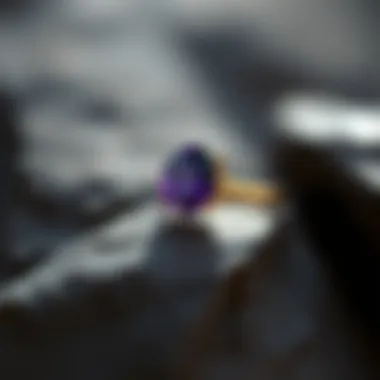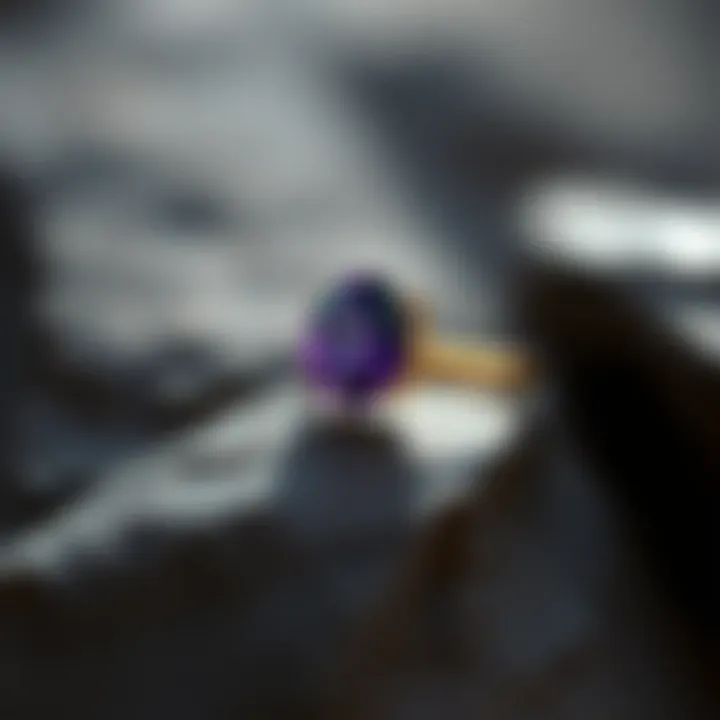Exploring the Allure of Purple Gemstones


History and Origins
The captivating world of purple gemstones is steeped in rich history and symbolism. These stones, characterized by their stunning violet hues, have been valued throughout centuries, not only for their beauty but for their mystique and perceived powers. From ancient civilizations to the modern age, purple gemstones have been revered as tokens of royalty and spirituality.
Overview of Collectibles, Rocks, and Fossils
Purple stones like amethyst, tanzanite, and charoite are more than mere decorative elements; they are pieces of Earth's history carefully encased in mineral structures. For avid collectors and enthusiasts, understanding the geological formation of these gemstones can enhance their appreciation and valuation. Amethyst, for instance, forms in volcanic rocks, an indicator of the geological activity that shaped our planet's crust over millions of years. Meanwhile, tanzanite, a relatively recent discovery, was first found in Tanzania in the 1960s and quickly captured the hearts of gem lovers worldwide.
Collectibles aren't just about owning beautiful objects; they represent a connection to history, nature, and sometimes, personal identity. Enthusiasts delve into local geology, the origins of each stone, and the tales they tell, transforming mere rocks into cherished treasures.
Historical Significance and Cultural Impact
Throughout history, purple gemstones have often been associated with luxury and spiritual beliefs. The deep violet of amethyst was once reserved for nobility in ancient Rome and Egypt. It was believed to hold protective qualities, preventing intoxication and promoting clarity of thought. Many rulers adorned themselves with amethyst-studded crowns, considering it a symbol of power and wisdom.
In various cultures, purple gemstones have appeared in folklore and mythology. The ancient Greeks thought amethyst was a gift from Dionysus, the god of wine, while the Egyptians ascribed protective powers to it in the afterlife. In more recent history, the emergence of tanzanite brought about a new wave of enthusiasm, especially when it was declared the 20th-century birthstone for December, adding to the modern narrative of purple gemstones.
"Purple gems are a unique blend of beauty and history, often reflecting the beliefs and aspirations of the cultures that esteemed them."
As we move forward, the exploration of these magnificent stones continues, shedding light on their properties and significance in jewelry and collectibles, shaping not only the market but also the individual stories they carry.
Identification and Classification
Understanding different purple gemstones involves recognizing their distinguishing qualities. With the market flooded with various options, identifying the right stone becomes essential for collectors and jewelry enthusiasts. Each variant has unique characteristics, making them special in their own right.
Guide to Identifying Rocks and Fossils
When it comes to identification, factors such as color intensity, clarity, and cut play crucial roles. For example, high-quality amethyst is known for its deep violet color, while others may present a lighter hue or a more bluish tint. Notably, the geographical location where a stone is mined can influence its coloration and overall quality, adding yet another layer of complexity.
Key Identification Features:
- Color: Deep purple is usually more sought after.
- Clarity: A clear, flawless stone can command a higher price.
- Cut: The style can enhance the appearance and value.
Collectors often refer to guides and classification charts to support their identification process. Online resources like Gem Society or Gemological Institute of America (GIA) are invaluable for beginner gemologists seeking detailed information.
Common Types and Variations
Among the many varieties of purple gemstones:
- Amethyst – The most recognized gemstone in this family, available in varied hues from lilac to deep purple.
- Tanzanite – Known for its striking blue-violet color, unique to a specific region.
- Charoite – A rare stone with swirling patterns, found only in Siberia.
Each stone contributes to the diverse landscape of purple gemstones, offering collectors a wide array of options to explore.
To delve deeper into the fascinating world of gemstones, resources like Britannica and gemstone-specific forums on Reddit can offer insightful discussions and updates.
Preamble to Purple Gemstones
Purple gemstones, a feast for the eyes and a treasure for collectors, hold a unique place in both nature and history. The allure of these stones extends beyond their captivating colors; it encompasses deep-rooted cultural meanings and varied practical applications. Enthusiasts of geology and jewelry alike find themselves drawn to the diversity of purple gemstones, which can range from the well-known amethyst to rarer varieties such as sugilite. In this section, we explore the essential aspects of purple gemstones, paving a path towards a richer understanding.
Defining Purple Gemstones
Purple gemstones are characterized not just by their hue, but also by their formation and rarity. The color purple emerges from a combination of trace elements that infuse the minerals with unique properties. In terms of classification, purple gemstones can be both precious and semi-precious. Precious stones like purple sapphires are highly valued, while others like fluorite might appeal more to the enthusiastic collector due to their beautiful yet more accessible nature.
Their significance transcends mere aesthetics; purple gemstones are often associated with royalty, spirituality, and healing. For many cultures, the color purple symbolizes wealth and wisdom, tying closely to the cultural narratives woven throughout history.
As we delve deeper into the world of purple stones, we uncover a variety of unique types, each holding its own story worth telling. Understanding these definitions lays the groundwork for appreciating the wonders of purple gemstones.
Historical Significance
The history of purple gemstones is rich and varied, filled with tales of empires and traditions. These stones have adorned the crowns of kings and queens, reflecting a status that denotes power and authority. Amethyst, for instance, was once considered to be a precious stone equivalent to diamonds, emeralds, or rubies during the Renaissance period.
In ancient Egypt, purple stones like amethyst were believed to have magical properties and were often used in amulets for protection. Meanwhile, purple jade was cherished in many Asian cultures, considered a stone that brings luck and serenity.
"Throughout history, purple gemstones have signified a connection to the divine, shaping their value and significance in various cultures."
Their place in history fuels a continuous interest in purple gemstones, showing that their impact extends far beyond their physical existence. Much like fine wine, the essence of these stones gains depth over time, reflecting the evolving taste of society as it embraces the symbolism, craftsmanship, and status associated with these remarkable treasures.
As we continue our examination of purple gemstones, we will uncover their classification, notable examples, and ways to appreciate their beauty and value in the contemporary world.
Classification of Purple Gemstones


Classifying purple gemstones serves as a crucial foundation for collectors and enthusiasts alike. Understanding the differences between various types of purple stones can enhance appreciation, influence purchasing decisions, and foster informed discussions among collectors. This classification provides clarity on the characteristics and value associated with each gemstone, illuminating the path to knowledgeable buying, selling, and collecting.
Natural vs. Synthetic
When diving into the world of purple gemstones, the distinction between natural and synthetic varieties emerges as a significant topic. Natural gemstones are formed over millions of years through geological processes, while synthetic stones are lab-created and often designed to mirror their natural counterparts.
Natural purple gemstones carry stories from the earth. They manifest unique imperfections and inclusions, tales of their formation that resonate with collectors. In contrast, synthetic gemstones, such as synthetic amethyst, can be produced quickly and often at a lower cost.
- Pros of Natural Gemstones:
- Cons of Natural Gemstones:
- Pros of Synthetic Gemstones:
- Cons of Synthetic Gemstones:
- Unique formations and inclusions
- Potentially greater value in the long-term
- Rich history and geological stories
- Often more expensive
- Variability in quality
- Consistent quality and clarity
- Generally more affordable
- No natural history
- Lower resale value
For collectors, the choice often boils down to personal preference. Some may find the allure of natural gemstones irresistible, while others might appreciate the perfection and value that synthetic options offer. The demand for each can vary based on market trends, which makes this classification vital for navigating purchases and investments in gemstones.
Precious vs. Semi-Precious
The category of purple gemstones further subdivides into two primary classifications: precious and semi-precious. This distinction historically arose from the popularity and market perception of specific stones.
Precious gemstones, including diamond, emerald, and ruby, generally acquire their status and value due to their rarity and the costs involved in their mining and processing. However, purple gemstones can also fall under this luxury umbrella. Notably, high-quality purple sapphires can demand prices comparable to these traditional precious stones.
Conversely, semi-precious gemstones exhibit wider availability and can vary vastly in quality and price. Amethyst is a prime example; though once valued highly, its abundance in certain regions impacted its perceived value. The classification stakes a significant claim on the market dynamics:
- Key Points on Precious Gemstones:
- Key Points on Semi-Precious Gemstones:
- Higher intrinsic value
- Rarer and often more desirable
- More common and accessible
- Varied pricing based on quality
Understanding this classification system—natural vs. synthetic and precious vs. semi-precious—equips collectors not just with knowledge, but also with the ability to navigate the complex gemstone market with confidence. It puts collectors in a position to pick the right specimens for their collections, ensuring that they appreciate not just the aesthetics of these purple wonders, but their worth in a saturated market.
Notable Purple Gemstones
Purple gemstones have a unique charm that captivates collectors and enthusiasts alike. These stones not only stand out for their vibrant hues but also for their varying attributes and historical significance. Examining notable purple gemstones allows us to delve deeper into the world of mineralogy and its interplay with culture, history, and economics. By focusing on individual stones, we can appreciate the distinct qualities they bring to both the collector’s shelf and the realm of personal adornment.
Amethyst
Origin and Formation
Amethyst, a member of the quartz family, forms through a fascinating geological process. It begins as clear quartz, but the introduction of iron and other trace elements during its formation causes the signature purple color. The geological environments where amethysts are found often contribute to their varying intensities of purple, ranging from pale lavender to deep, royal shades. This variability in color can significantly influence the stone's desirability among collectors, as darker hues tend to be favored.
One of the key characteristics that set amethyst apart is its relative abundance compared to other precious stones. Its widespread availability allows it to be a popular choice for both novice and seasoned collectors while still maintaining distinct charm. However, certain high-quality specimens can fetch impressive prices, making them both a potential investment and a stunning addition to any collection.
Cultural Impact
Amethyst has a long and rich history within various cultures. The ancient Greeks believed it to be a protective stone against intoxication, hence the name—which translates to "not intoxicated." In many cultures, amethyst symbolizes peace, balance, and courage. This cultural significance permeates art and literature, showcasing amethyst not only as a gemstone but as a symbol of nobility and spiritual growth. Such associations enhance its appeal, making it not just a beautiful stone but also one with deep-rooted significance.
Collectors are often drawn not just to its aesthetic but to what amethyst represents in various narratives and stories throughout history. It holds a respected place in jewelry worn by royalty and sacred items in religious practices, making it a treasure that comes with its strong stories.
Uses and Applications
Besides its traditional use in jewelry making, amethyst finds its place in other fields. For instance, it's commonly used in healing practices, believed to promote clarity and calmness. Amethyst geodes can enhance the aesthetic of any room, serving both decorative and metaphysical purposes. This versatility increases its desirability amongst those looking to blend beauty with function.
Furthermore, due to its affordability, amethyst serves as an entry point for many in the world of gemstone collecting. Its various forms—jewelry, raw specimens, or polished pieces—cater to diverse tastes and purchasing power, which keeps it relevant among both casual buyers and serious collectors.
Purple Sapphire
Characteristics
Purple sapphires are often distinguished by their clarity and brilliance, which can outshine many other gemstones when properly cut. The core components that contribute to their allure include their durability and scratch resistance, making them not only beautiful but immensely practical for wearable pieces. The stone’s unique hue may result from the presence of titanium and iron, setting it apart from other varieties of sapphire.
A notable aspect of purple sapphires is their rarity compared to blue sapphires, making them a prized find for collectors. The striking color can vary slightly from lavender to a deep purple, often akin to amethyst but possessing a hardness that makes it suitable for intricate jewelry designs. This combination of characteristics positions purple sapphire as a high-value gemstone in the eyes of many.
Market Value
The market value of purple sapphires can vary based on several criteria: color saturation, clarity, cut, and carat weight all play a role. The rarer the shade and the better the quality, the higher the price tag. Unlike other purple gemstones, sapphires generally maintain their value over time, with some high-quality pieces appreciating substantially, making them a sound investment.


When considering gemstones for collection, purple sapphires often present strong market opportunities. This market demand not only reflects their aesthetic appeal but their versatility in both high-end jewelry and investment markets, aiding collectors in diversifying their portfolios.
Famous Examples
Several notable purple sapphires have made headlines over the years, notably the royal jewelry collections. For example, the necklace worn by Princess Diana, featuring a stunning purple sapphire, has attracted immense attention and left an indelible mark on the gemstone’s popularity.
These famous pieces not only elevate the glamour attached to purple sapphires but also create a narrative around them. Collecting or investing in famous items—either replicas or original pieces—adds prestige and recognized worth to any collection.
Lavender Jade
Geological Origins
Lavender jade originates from specific deposits predominantly in Myanmar, where geological conditions contribute to its unique coloration. The presence of manganese gives the jade its pastel purple hues, which can vary in intensity. The mining processes and conditions affect the ketones present in jadeite that contribute to the enchanting colors collectors seek.
Jade has long been esteemed in various cultures, particularly in East Asia, and lavender jade speaks to a niche of collectors attracted to its rarity and beauty. This geological uniqueness enhances its desirability, especially those looking for distinctive additions to their collection.
Cultural Significance
In many cultures, jade carries spiritual significance, often linked with virtue and moral integrity. Lavender jade, more specifically, invokes serenity and peace, traits that many cherish. Collectors are drawn not only to its rarity but also to the aura of calm it imparts.
This strong cultural association encourages collectors and enthusiasts to look beyond mere aesthetics, as the significance often enhances the value of the piece. The combination of beauty and meaning allows lavender jade to stand out in the realm of gemstones.
Collecting Lavender Jade
Collectors interested in lavender jade must be discerning. Not all pieces are created equal, and the market is rife with imitations. Authentic specimens are rare and often command higher prices. Understanding the unique characteristics of lavender jade is crucial for serious collectors. That said, its radiance and connotations of purity and tranquility can make it incredibly rewarding to some who seek authentic pieces.
Iolite
Visual Properties
Iolite is known for its pleochroism—a unique visual characteristic that allows it to display different colors when viewed from different angles, appearing violet, blue, or grayish hues. This optical phenomenon makes iolite a captivating choice for jewelry, as each turn catches light in a new way. It lends an air of complexity that appeals to collectors.
The visual appeal of iolite often leads both jewelers and collectors to seek out stones that exhibit high clarity and rich color saturation. Despite being lesser-known, its unique properties can spark interest and showcase versatility in various jewelry designs or settings.
Identification Tips
Identifying quality iolite can be as simple as examining how it shifts colors under different light sources. Collectors and enthusiasts should pay attention to the stone’s clarity and the absence of visible inclusions. Familiarity with iolite’s optical behaviors enables collectors to distinguish genuine specimens from imitations, which is vital in an often muddled market.
Having the right know-how can enhance the collecting experience, ensuring that enthusiasts obtain pieces that truly reflect the quality and essence of iolite.
Trade and Value
Iolite’s market value fluctuates based on demand and the quality of the stones available. While it doesn’t quite reach the price heights of sapphires or amethysts, its relative rarity and unique properties can yield impressive investments for collectors savvy enough to spot a good piece.
Additionally, as interest in this lesser-known gemstone grows, so does its relevance in collector’s circles, potentially leading to increased values in future markets.
Sugilite
Rarity and Mining
Sugilite is a rare mineral, with significant deposits found primarily in South Africa. Its fetching purple color, often with black streaks, makes it a popular choice among collectors. However, the rarity of high-quality sugilite means that it can be challenging to find. The mining processes can be resource-intensive, affecting availability and price point.
Because of its scarcity, sugilite commands a certain allure that can entice collectors looking for a unique find. It offers something different from more common stones while also carrying a narrative of discovery and quest in its very essence.
Healing Properties
Many believe sugilite comes with powerful healing properties, often linked to emotional healing and spiritual growth. Although more esoteric, these associations contribute to the gemstone’s appeal. For collectors interested in the metaphysical aspect, sugilite can serve as both a decorative and a spiritual piece.
This dual-purpose characteristic allows it to cater to a wider audience—those who collect for beauty and those who seek what they believe is a connection to deeper energies.
Cultural Associations
Sugilite holds cultural significance in certain communities, often associated with compassion and love. This cultural connection enhances the value of sugilite in the eyes of collectors seeking stones that resonate not just visually but also metaphorically. The added depth can create a strong pull for those wanting to comprehend the stories behind their collections, blending art with awareness.
Appraisal and Valuation of Purple Gemstones
Understanding the appraisal and valuation of purple gemstones is crucial for any collector or enthusiast in the field. This segment sheds light on why these elements matter, taking into account the nuances that influence the worth of these captivating stones. Proper evaluation not only ensures fair trading but also assists collectors in making informed decisions regarding their investments. Despite the beauty of purple gemstones, their value can fluctuate based on various factors. Therefore, mastering the intricacies of gemstone appraisal is essential for anyone who wants to truly appreciate and perhaps even profit from these exquisite treasures.
Factors Influencing Value
When it comes to determining the value of purple gemstones, several factors come into play:


- Color Quality: Not all shades of purple hold the same value. The richness and intensity of the color can significantly affect the price. For instance, a deep royal purple may be much more desirable than a paler version.
- Clarity: This refers to the presence of internal or surface flaws. A gemstone that is clean and clear, showing minimal inclusions, generally commands a higher price.
- Cut and Shape: Just like a well-cut diamond, the cut of a purple gemstone influences its brilliance and beauty. Different shapes, whether oval, round, or cushion, can also cater to varying tastes and may impact the resale value.
- Carat Weight: Larger stones often come at a premium, but this is not a hard and fast rule. The stone's characteristics must align with its size to justify a higher value.
- Origin: The place where the gemstone is sourced can add educational allure and value. For instance, purple sapphires from Kashmir are famously sought after.
- Market Demand: Current trends and consumer interest can sway values. Stones that are popular in contemporary designs, such as amethyst and lavender jade, can witness soaring prices due to increased demand.
"Knowledge is power; understanding the finer details of gemstone appraisal can enhance one’s collection and financial investment.”
Common Appraisal Techniques
There are various ways to assess the value of purple gemstones, and familiarizing oneself with these techniques allows for a more informed purchasing or selling process:
- Visual Inspection: This is often the first step, where an experienced gemologist examines the stone under natural light. They look for color saturation, clarity, and any visible flaws.
- Gemological Testing: Utilizing tools such as refractometers, spectroscopes, and dichroscopes can provide precise measurements and evaluations. These scientifically backed methods help to confirm the identity and quality of the gemstone.
- Comparative Analysis: This technique involves comparing an individual gemstone with similar stones that have recently sold. By reviewing sale prices of comparable gems, one can gauge market trends and set appropriate valuations.
- Certification Reports: Gemstones appraised by reputable labs will typically come with a certificate indicating their quality, which can serve as a significant asset during resale. Knowing that a purple sapphire has been evaluated by the Gemological Institute of America (GIA), for example, can substantiate its worth in the buyer's eyes.
- Professional Appraisals: Finally, for high-value transactions, it's always a wise choice to get a professional appraisal from a certified gemologist. This could provide additional peace of mind to both parties in a sale.
Understanding and applying these appraisal techniques can bolster one's expertise in the fascinating world of purple gemstones, ultimately leading to informed decisions whether buying or selling.
Care and Maintenance
Caring for and maintaining purple gemstones is crucial not just for their beauty but also for preserving their inherent value. These unique stones, whether they're amethyst, purple sapphire, or iolite, require attention to detail in order to maintain their luster and prevent damage. Proper care ensures that collectors and enthusiasts can enjoy these gems for years to come, possibly enhancing their market value and aesthetic appeal.
Cleaning Recommendations
Cleaning is the first step in maintaining the beauty of purple gemstones. Regular cleaning prevents build-up of dirt and oils, keeping the gemstones sparkling. Here are some tips for effective cleaning:
- Mild Soap Solution: A simple mix of warm water with a gentle, non-abrasive soap works wonders. Always remember to use a soft cloth or a microfiber towel. Avoid harsh cleaning agents that can dull the stone's surface.
- Gentle Scrubbing: For pieces with intricate designs, using a soft-bristle toothbrush can help reach those tough spots without scratching the gemstone.
- Soaking: Occasionally, soaking the stone in a soap solution for 10-15 minutes can loosen stubborn grime. Rinse thoroughly with warm water afterward to avoid leaving soap residue.
"A well-cared-for gemstone shines brighter in more ways than one."
Storage Guidelines
Storing purple gemstones properly is just as important as cleaning them. Improper storage can lead to scratches or even worse, chips. Here’s how to store your cherished purples:
- Use Individual Pouches: Storing each gemstone in a soft pouch or wrapped in tissue paper can help prevent them from scratching each other.
- Avoid Excessive Sunlight: Keep gemstones away from direct sunlight, as prolonged exposure can fade their vibrant colors. A cool, dark place is suitable for storage.
- Consider a Jewelry Box: If you have a collection, investing in a jewelry box with compartments can help organize the stones while protecting them from dust and damage.
Handling Tips
Lastly, how you handle your purple gemstones can greatly affect their longevity. Follow these tips to ensure safe handling:
- Clean Hands: Before touching your gemstones, wash your hands. Oils and dirt from your fingers can be transferred to the stone.
- Avoid Wearing Them During Activities: If you are engaging in hands-on activities, such as cleaning or exercising, consider removing any gemstone jewelry to avoid accidental damage.
- Mind the Temperature Changes: Sudden changes in temperature can cause thermal shock that might lead to cracks. Handle your gemstones with care, especially when moving them from one environment to another.
By following these care and maintenance tips, collectors can retain the integrity of their purple gemstones, ensuring their beauty remains timeless.
Purple Gemstones in Jewelry
Purple gemstones have carved a niche in the jewelry sector, drawing admirers with their unique shades and deep cultural significance. They stand out not just for their colors but for the stories and associations they carry. This section will delve deep into the trends shaping the jewelry designs featuring purple stones and spotlight some of the most iconic pieces ever created.
Trends in Jewelry Design
Current trends in jewelry design often reflect the broader cultural movements and technological advancements of the day. In the realm of purple gemstones, there are several key trends worth noting:
- Sustainability: More designers are prioritizing ethical sourcing of purple gemstones like amethyst and lavender jade. This shift caters to environmentally conscious consumers who value not only beauty but also the origins of their jewelry.
- Mixing Materials: Recent styles showcase a blend of purple stones with various metals, such as rose gold and platinum. This combination creates striking contrasts that enhance the natural allure of the gemstones.
- Unique Cuts: While traditional cuts remain popular, custom designs featuring asymmetrical or organic shapes are gaining traction. Such designs give a more artistic flair to purple gemstones, allowing individuality to shine through.
- Layering Techniques: Fashionable jewelry now often includes layered pieces that incorporate purple stones alongside other gems. This trend allows wearers to express themselves in a more personalized manner, favoring bold combinations over minimalist approaches.
Incorporating these trends not only offers a fresh take on purple gemstones but also enhances their appeal in modern jewelry markets.
Famous Jewelry Pieces Featuring Purple Stones
The world has seen many breathtaking jewelry pieces that feature purple gemstones, each telling its own tale of elegance and history. Here are some standout examples:
- The Queen Mary’s Amethyst Necklace: This stunning piece was originally crafted for Queen Mary of Teck in the early 20th century. It showcases large, square-cut amethysts surrounded by diamonds, underscoring the regal quality of purple gemstones in haute couture.
- The Duchess of Windsor's Purple Sapphire Necklace: Crafted in the mid-20th century, this necklace is noted for its rich purple sapphires, taking center stage at high-profile events, including royal gatherings. Its design embodies sophistication and timeless beauty.
- Nicole Kidman's Lavender Jade Earrings: During various award ceremonies, Nicole Kidman has donned striking lavender jade earrings that demonstrate the versatility and elegance of this particular gemstone, marrying modernity with tradition in a dazzling fashion.
- Elizabeth Taylor’s Amethyst Ring: Known for her extensive jewelry collection, Elizabeth Taylor showcased a spectacular amethyst ring that captured the fascination of many collectors. This piece not only highlighted her love for purple stones but also set a trend for similar designs in the years that followed.
Each of these pieces emphasizes the enduring appeal and timeless nature of purple gemstones in the high-end jewelry market, solidifying their place in the hearts of collectors and lovers of fine adornments alike.
Purple gemstones not only enhance aesthetic appeal but also carry profound cultural and historical significance in the world of jewelry.
With these insights, collectors can appreciate the depth behind purple gemstones and their intrinsic worth in the realm of luxury jewelry.
Ending
As we round off this exploration into the world of purple gemstones, it's clear that these remarkable stones hold more than just visual allure; they embody a rich tapestry of history, culture, and craftsmanship. Each gemstone tells its own story, intertwined with the stories of those who cherished them throughout the ages. This article's examination of purple gemstones underscores, among other things, their distinct properties and the compelling reasons why collectors and enthusiasts are drawn to them.
The Enduring Appeal of Purple Gemstones
Purple gemstones like amethyst, purple sapphire, and iolite are not just embedded in the landscape of luxury jewelry but are also deeply rooted in various cultures worldwide. The almost mystical color speaks to many. Historically, purple has been associated with royalty and high status due to its rarity in nature. This cultural significance adds layers to the appeal of these stones, making them not merely decorative but symbols of power and influence.
- The psychological impact of the color purple can evoke feelings of spirituality and tranquility, which can also contribute to their desirability.
- Collectors often find themselves captivated, not only by the stones' beauty but by their complex geological origins and the narratives embedded in each piece.
Moreover, the market for purple gemstones continues to evolve, adapting to present-day trends while holding onto their timeless charm. The demand for unique and ethically sourced specimens is gathering momentum, as knowledgeable buyers seek to invest not just in something that shines but also comes with a compelling story.
This comprehensive look at purple gemstones does not only serve to educate; it encourages a deeper appreciation for what these stones symbolize and the lasting relationships between people and the earth from which they come. Therefore, understanding their cultural relevance and value can enrich one’s collection and extend beyond mere ownership into a realm of passionate curation and storytelling.
"Each stone carries with it a whisper of its past, a tale waiting to be told across generations."



